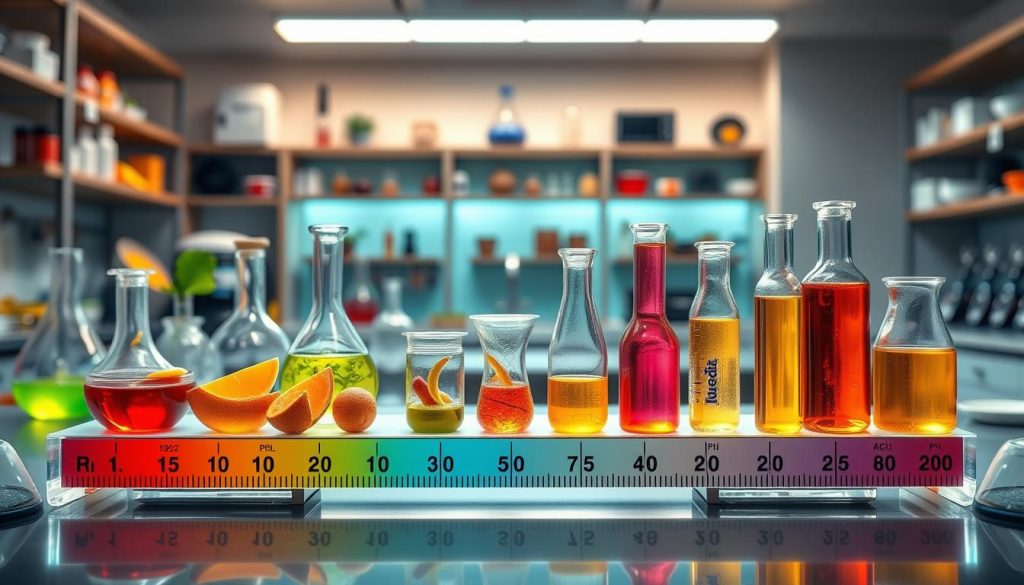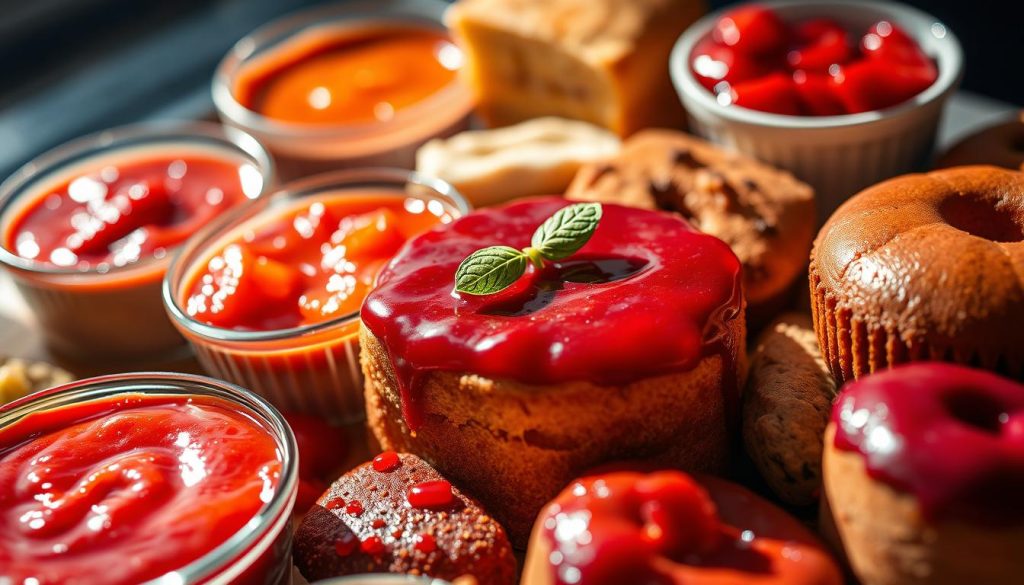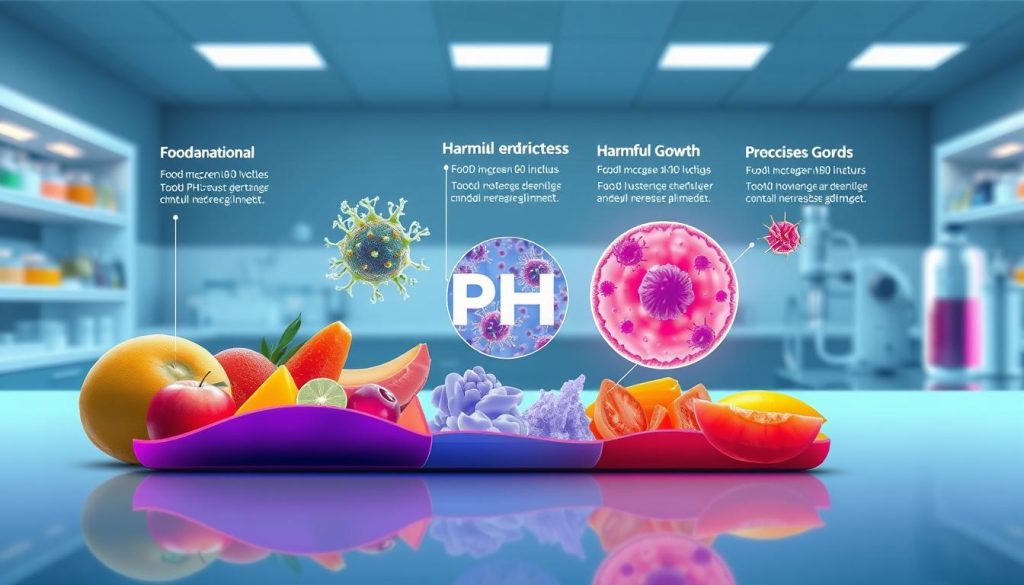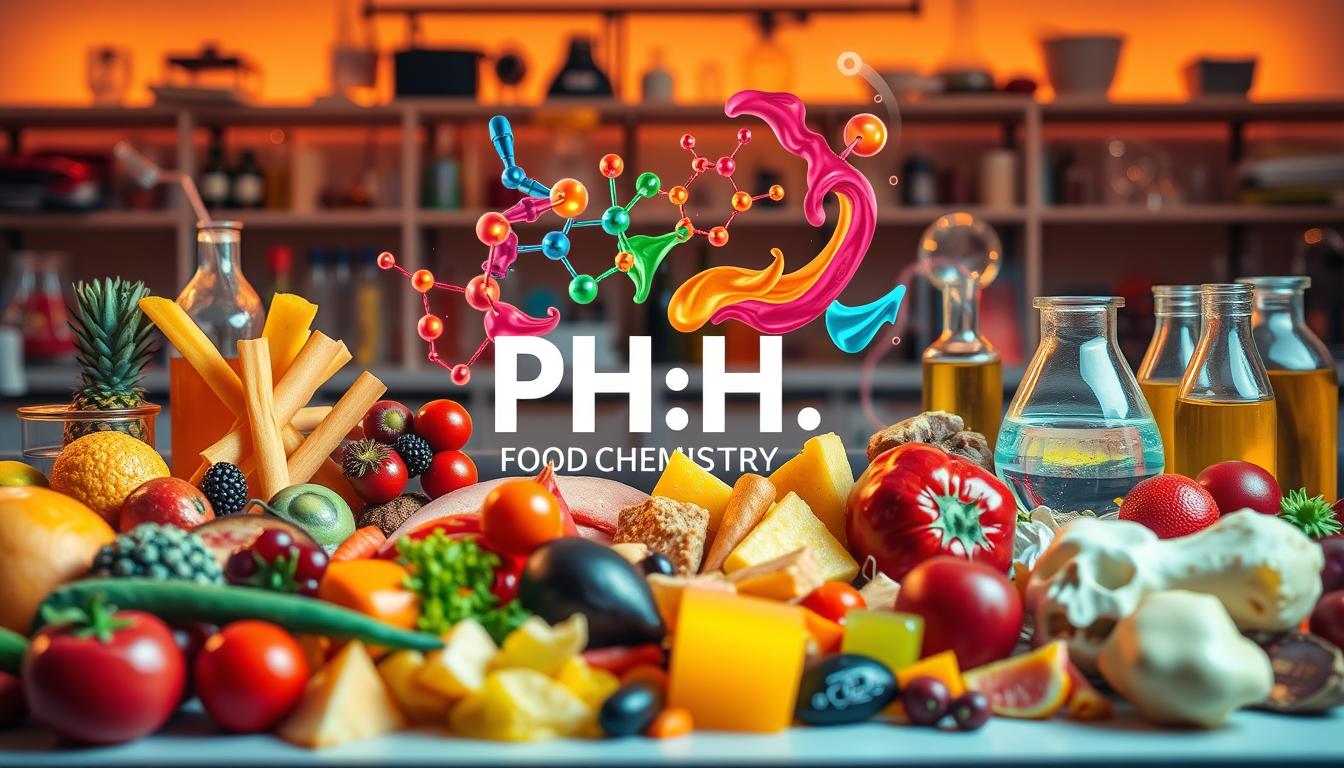Did you know your tongue detects sourness 1,000 times faster when acidity increases by just 0.3 units? This invisible chemical measurement quietly determines whether your steak stays juicy, pickles crunch perfectly, or chocolate mousse holds its shape. What we perceive as delicious often comes down to precise hydrogen ion concentrations.
Acidity levels act like a culinary puppet master. They control how proteins fold in cheese-making, prevent apples from browning, and even decide when bread dough stops rising. Bakers adjust batter alkalinity to create airy cakes, while brewers carefully monitor fermentation stages using this critical measurement.
Your favorite snacks achieve their signature mouthfeel through calculated balance. The crispness in dill pickles comes from vinegar’s sharp bite (pH 2.4), while creamy yogurt needs milder acidity (pH 4.5) for smooth texture. Even water’s mouthfeel changes dramatically below 6.5 or above 8.5 on the scale.
Modern food science uses this knowledge to revolutionize products. Plant-based meats mimic animal tissue behavior through pH-controlled protein structuring. Beverage companies engineer thirst-quenching sensations by optimizing citrus acidity against sweeteners. Mastering these principles separates ordinary cooking from extraordinary culinary artistry.
Key Takeaways
- Acidity levels directly impact how quickly we perceive sour tastes
- Food textures from crunchy to creamy depend on precise hydrogen ion balance
- Professional kitchens use pH control for consistent cooking results
- Meat tenderness and baked goods’ rise rely on specific acidity ranges
- Food preservation methods leverage acidity to prevent spoilage
- Modern food innovations require advanced pH management techniques
Understanding pH: The Foundation of Culinary Chemistry
Imagine altering a cake’s texture or preserving pickles simply by controlling invisible particles. This power lies in mastering hydrogen ion concentrations – the core concept behind pH. Every kitchen becomes a laboratory when you grasp how this 0-14 scale dictates ingredient behavior.

Defining pH and Its Relevance to Food Chemistry
The pH scale measures acidity or alkalinity through hydrogen ion activity. Danish scientist Søren Sørensen’s 1909 discovery revolutionized food preparation. A lemon’s sharp bite (pH 2) contains 10x more hydrogen ions than vinegar (pH 3) due to the logarithmic scale.
Your ingredients constantly battle for balance. Milk’s near-neutral pH (6.5-6.7) allows proteins to remain stable, while baking soda’s alkalinity (pH 8.3) triggers rising reactions in batters. Even water’s mineral content alters this delicate equilibrium.
From Laboratory Measurements to Kitchen Applications
Modern chefs wield pH meters like seasoned scientists. Digital tools and test strips provide instant acidity readings. “Control the hydrogen ions, and you command the dish’s destiny,” observes Michelin-starred chef Elena Martinez.
Practical pH management starts with understanding local water chemistry. Hard water alters dough elasticity and brewing outcomes. By measuring ingredient acidity levels, you can predict how tomatoes (pH 4.2-4.9) will interact with alkaline elements in sauces.
Master these principles, and you’ll transform random recipes into calculated chemical reactions. Your preserved foods will crunch longer, emulsions stay stable, and baked goods achieve perfect rise – all through hydrogen ion mastery.
The Role of pH in Flavor and Texture
Your taste buds dance to acidity’s tune. Every squeeze of lemon or dash of baking soda rewires flavor perception and transforms mouthfeel. Master this balance, and you’ll unlock dishes that sing with clarity.

Enhancing Taste Profiles Through pH Adjustment
Acidic ingredients act like flavor amplifiers. When you add lime juice to ceviche (pH 2.8-3.4), hydrogen ions activate TRPV1 receptors, creating that bright zing. Lower pH levels suppress sweetness – that’s why rhubarb needs sugar despite its natural sugars.
Try this trick: balance overly sweet desserts with a pinch of citric acid. You’ll notice berry flavors become more vibrant without added sugar. Vinegar-based dressings demonstrate how acidity alkalinity balance makes bitter greens taste milder.
Transforming Texture in Culinary Creations
Ions in acidic solutions reshape proteins and starches. Yogurt firms up at pH 4.6 as casein proteins coagulate. In baking, dough’s acidity affects gluten strength – bagels need alkaline water (pH 8-9) for chewy crusts.
| Food | pH Range | Texture Impact |
|---|---|---|
| Ceviche | 2.8-3.4 | Firms fish proteins |
| Yogurt | 4.0-4.6 | Creates smooth gel |
| Bread Dough | 5.0-5.8 | Controls rise time |
| Mayonnaise | 3.8-4.2 | Stabilizes emulsion |
Watch sauces thicken magically when pH hits starch’s gelatinization point. Hollandaise stays silky because lemon juice (pH 2.0) keeps egg proteins from curdling. Your kitchen experiments become predictable science once you track these patterns.
pH and Food Safety: Preventing Microbial Growth
Your kitchen’s defense against foodborne illness starts with acidity control. Pathogens struggle to survive when hydrogen ion concentrations disrupt their cellular functions. This natural barrier explains why preserved foods remain edible for months without artificial additives.

Impact of pH on Bacterial Activity and Spoilage
Dangerous microorganisms thrive in neutral zones (pH 6.5-7.5). Below 4.6, botulism spores become inactive – a critical threshold for canning safety. Fermented vegetables achieve this through lactic acid production, while citrus marinades create hostile environments for salmonella.
Consider these microbial patterns:
- pH 2-4: Stops most foodborne pathogens
- pH 4.6-7: Allows mold/yeast growth
- Above pH 8: Disrupts bacterial cell membranes
Enzymatic spoilage slows dramatically in acidic conditions. Apples dipped in lemon juice (pH 2.0) resist browning 5x longer than untreated slices. This principle extends shelf life while maintaining texture.
Maintaining Nutrient Stability for Safer Foods
Acidic environments protect vital nutrients. Vitamin C retains 90% potency in pH 3.5 compared to 50% at neutral levels. Tomato-based sauces preserve lycopene better than alkaline preparations through careful pH management.
“Pathogens can’t multiply below pH 4.6,” explains food safety specialist Dr. Linda Carter. “This creates a biological forcefield in preserved foods.” Modern processors use this knowledge to design shelf-stable products without excessive preservatives.
Adjust acidity strategically using vinegar brines or citric acid powders. Test pH levels during fermentation to ensure beneficial bacteria outcompete harmful strains. Your preserved creations will stay safe and nutritious for months.
Mastering pH Adjustment: Techniques and Best Practices
Transform ordinary dishes into culinary masterpieces through precise acidity control. Strategic adjustments unlock vibrant flavors and ideal textures while safeguarding your creations.
Using Acidic and Alkaline Ingredients Effectively
Citric acid and lemon juice become your flavor-sharpening allies. Add them gradually – ¼ teaspoon can lower 1 cup of sauce by 0.5 pH units. For alkaline adjustments, baking soda (pH 8.3) neutralizes excess acidity in tomato sauces without dulling their brightness.
Monitoring pH with Reliable Tools and Methods
Digital meters provide lab-grade accuracy for critical recipes like fermented foods. “Calibrate weekly using pH 4 and 7 solutions,” advises pastry chef Marco Visconti. Test strips work well for quick checks during canning or brewing.
Buffering techniques maintain stability in complex dishes. Combine 1 part citrate buffer with 10 parts liquid to resist pH shifts from added ingredients. Follow this workflow:
- Measure baseline acidity
- Add adjusters in 0.1% increments
- Retest after 2 minutes
Record results in a pH log to refine future recipes. This systematic approach prevents over-correction while ensuring consistent food safety and texture outcomes across batches.
pH in Fermentation and Enzymatic Activity
Microbial activity in food isn’t random—it’s a pH-controlled dance. Beneficial organisms thrive while harmful ones get eliminated through strategic acidity adjustments. This delicate balance determines whether your kimchi develops complex flavors or becomes a science experiment gone wrong.
Optimizing Fermentation Processes for Flavor Development
Lactobacilli dominate at pH 4.6-5.3, transforming cabbage into tangy sauerkraut. Yeasts in sourdough prefer slightly acidic conditions (pH 3.8-4.5) to produce distinct aromatic compounds. By adjusting initial acidity, you steer microbial growth toward desired flavor profiles.
Cheese makers manipulate environments to favor specific bacteria strains. Blue cheeses hit pH 4.8-5.5 during aging, allowing mold activity that creates bold flavors. Kombucha brewers maintain pH 2.5-3.5 to prevent spoilage while encouraging acetic acid development.
Controlling Enzyme Reactions for Ideal Texture
Enzymes in dough become hyperactive below pH 5.0, leading to overproofed bread. Proteases in meat tenderizers work best at pH 5.5-6.0, breaking down collagen without making mush. Fruit processors use citric acid dips (pH 2.0-2.5) to deactivate browning enzymes.
Baking chemistry relies on precise acidity to control starch gelatinization. Cake batters rise evenly when pH stays between 6.0-6.5, creating ideal conditions for baking powder reactions. Track these variables, and your textures transform from accidental to intentional.



